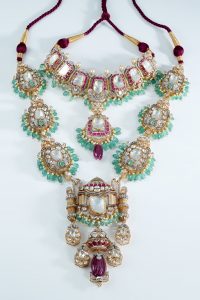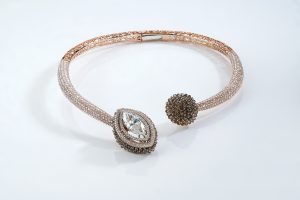By Shaan Bajaj
A quick and easy guide to buy wedding jewellry, with insight from Khanna Jewellers.
A woman’s wedding jewellery feels sacred, with some families starting years before she’s even old enough to find a partner, while grandmothers and close aunties might even take a peek in their own treasure boxes, for an ornament to
pass on to you on your special day. As a blushing bride-to-be, you may receive jewellery from family members, along with jewellery from your partner’s family, but you will also have to buy a couple of pieces and your own wedding set. Since jewellery is often an investment and a statement of your own personal style, buying your wedding jewellery is a significant step on your (very long) wedding to-do list.
To help you get started, Masala has put together a helpful guide, along with advice from highly-acclaimed Khanna Jewellers.
First things first, what type of jewellery is available?
Understanding the different types of work, their aesthetic, and value, will play important factors in your decision making process.
 Jadau refers to a jewellery-making technique that traces back to the Mughal empire, however, it has been perfected by the Rajasthani and Gujarati craftsmen. The gold is framed for uncut diamonds, pearls, or precious stones, they are then embedded into the gold, without the use of any bonding element. This process is used for polki, kundan, and meenakari jewellery. It is made entirely by hand, therefore a big set can take months to complete.
Jadau refers to a jewellery-making technique that traces back to the Mughal empire, however, it has been perfected by the Rajasthani and Gujarati craftsmen. The gold is framed for uncut diamonds, pearls, or precious stones, they are then embedded into the gold, without the use of any bonding element. This process is used for polki, kundan, and meenakari jewellery. It is made entirely by hand, therefore a big set can take months to complete.
Kundan jewellery uses this process, but kundan specifically refers to the purest form of gold. The gold used to encase the stones and diamonds is 24k gold. While polki jewellery refers to uncut diamonds, this can be set in a kundan frame, and the technique used to make the set is called jadau. A set like this would be called a kundan polki set. If you are looking for a traditional set, one that will make you feel like royalty on your wedding day, look out for these sets.
Look out for:
– The purity of gold that is used: it should be 22k gold or higher
– If the embedded stones are precious or semi-precious
– Kundan jewellery uses 24k gold, so ask your jeweller for a certificate
 One of the most sought after and stunning looks is one that uses diamond and gemstone sets. From an array of just diamonds or a mix of diamonds and stones, a diamond set will look just as sparkly many years down the line. It is a popular choice amongst brides for their reception or sangeet. Don’t be afraid to add a hint of colour with a variety of precious stones like emeralds, rubies, tanzanite, and more.
One of the most sought after and stunning looks is one that uses diamond and gemstone sets. From an array of just diamonds or a mix of diamonds and stones, a diamond set will look just as sparkly many years down the line. It is a popular choice amongst brides for their reception or sangeet. Don’t be afraid to add a hint of colour with a variety of precious stones like emeralds, rubies, tanzanite, and more.
What should you consider before buying a piece of jewellery?
• Is this going to be an investment piece?
• What is its re-sale value?
• Can you see yourself using it in the future?
• Do you feel comfortable wearing it? There is nothing worse than earrings that are too heavy to wear.
• Does it represent your style?
Tips:
• When buying necklaces, think of how it would fit into your wardrobe and current lifestyle. Think about buying multi-purpose necklaces, where they are either detachable, reversible, or maybe even consider layering two necklaces for your wedding, that you can then use separately.
• Before you choose your wedding lehenga, buy your set. People often mistakenly think you should buy your outfit first, however your wedding set will be a bigger investment. This way, you will be able to customise the neckline of your outfit to suit your set, rather than vice versa.
• Once you buy your set, there are two people you have to discuss it with. Firstly, your bridal outfit designer, to ensure they fit the aesthetic and there is no clash between metals or work. Secondly, your hair dresser. They will help you decide hairstyles, and how to hold up the various pieces, especially if you will be wearing a tikka or nath.
• If you are in doubt, look for timeless pieces over trending pieces.
• One of the best pieces to invest in is earrings. They are incredibly versatile, and can make a statement when needed.
• Invest in a few basic gold pieces that can be worn with Indian and Western wear.
Masala asked Kartik Khanna, Creative Director of Khanna Jewellers, for his expert insight on what to look out for when buying your wedding jewellery.
 How many sets do you recommend a bride purchases? And what type of sets would you recommend?
How many sets do you recommend a bride purchases? And what type of sets would you recommend?
I would suggest six, including the wedding set. The reason for this is to make sure the bride has a variety. I would suggest at least the wedding set first, as it is usually more traditional, using either polka or gold. Additionally, I would recommend adding a diamond set with coloured stones or diamonds.
Which type of set has lasted the test of time?
Diamonds, specifically a solitaire string on a necklace, is a timeless piece.
What new jewellery trends have you seen recently?
Nowadays brides are looking for small chokers, stackable bracelets, everyday jewellery, and statement earrings.
What are the most valuable sets to have as an investment and would you be able to sell them back?
Selling jewellery back is fairly easy, as most jewellers have a buy-back policy. In terms of investing in value, look for bigger pieces with diamonds, or sets which include real and high- quality coloured stones, like emeralds and rubies.
What is the biggest mistake you can make when buying wedding jewellery?
People sometimes compromise on the making costs, and go for alternative and cheaper makes. In the long run, I feel like that is a really bad decision, because a product can only speak to its lifespan. People look at making costs a lot, but a well-made piece will last the test of time.
Another mistake is that sometimes people look at trends rather than buying pieces that really speak to them.
 How can you take care of your wedding jewellery and make sure it retains its shine?
How can you take care of your wedding jewellery and make sure it retains its shine?
Storing and packaging is one of the major points, you should store all the different pieces individually in plastic pouches, and then place them in cushion boxes. Try to avoid the new fancy boxes, because they have a lot of chemicals, and these react with gold and stones, and might cause colour changes.
about us | contact us | feature a wedding | advertise with us | tiwa
2019 © masalawed.com ALL RIGHTS RESERVED